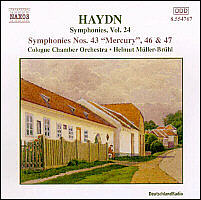Symphony No.43 in E flat major, given the nickname ‘Mercury’ perhaps as an indication of its use as incidental music for one of the many theatrical performances staged at Esterháza, was written in 1770 or 1771, the period of the Opus 17 string quartets and much else. Scored for pairs of oboes and horns, with strings, the symphony opens with a series of dynamic contrasts in the presentation of the first subject, leading to a more lyrical second subject and a particularly pleasing closing section. The central development begins with a motif from the first subject and an anticipation of the recapitulation that is to come, after two further anticipations of the first subject. The A flat major slow movement of a work that Robbins Landon, in his authoritative work on Haydn, describes as a chamber symphony opens with muted strings, while, as elsewhere in the symphony, there is little independent writing for the wind instruments, which here also play a largely supporting rôle. The movement is in the formal three sections of sonata form, with a central development and recapitulation. The Menuetto, taken at an appropriately steady pace, has a contrasting Trio that touches briefly on the key of C minor and B flat major, before returning to the home key. The last movement, again in tripartite form, entrusts the first subject of the opening exposition to the first violin, leading to the rapider figuration of the secondary material, an excitingly dramatic development and a varied recapitulation.
